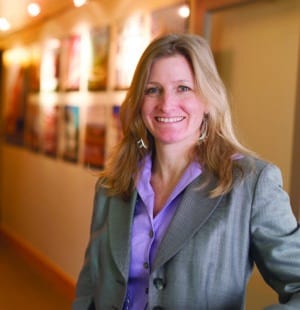Michelle Apigian
Senior Project Manager, Practice and Sustainability Leader, ICON Architecture
Age: 47
Industry experience: 20 years
Michelle Apigian is a leader in Massachusetts’ “passive house” movement, spreading the word on how tightly-insulated building envelopes can deliver energy savings to building owners. She is a board member of the Passive House Massachusetts, a nonprofit that provides educational programming to the real estate industry and community leaders on the latest research in optimizing buildings’ energy savings. At Boston-based ICON Architecture, Apigian was part of the design team for Concord Highlands, Cambridge’s biggest 100-percent affordable housing development in over 40 years.
Q: Was Concord Highlands initially envisioned as a passive house project?
A: This is a 98-unit affordable housing project by [Cambridge developer] Homeowner’s Rehab. Like most community development corporations, they have a very strong focus on sustainability, in part because they are long-term owners, and it makes eminent sense in resonating with their mission for healthy homes and resiliency. So they have tended to, with each project, push the envelope more and more from a performance perspective. We won the RFP and we were coming in with an approach to do it as a passive house building.
Initially their thought was, “The goal is great, but we’re never going to be a passive house building.” And we thought, “We’re going to do our best to design it as if it were, and see.” We benefited from having a general contractor on board early and testing different assembly ideas and value engineering choices. Because the Massachusetts Clean Energy Center wants to promote Passive House as well, they issued a design challenge last fall. There are seven projects that won awards and ours was one of them.
Q: What are the additional upfront costs of passive house construction?
A: That is the burning question. You’ll hear 2 to 5 percent additional upfront costs. I would argue you can do it at parity, but it’s a value proposition. You have to evaluate what your priorities are. That might be [eliminating] granite countertops. If you start with the thermal envelope as a priority, you might have to make different decisions about finishes.
Q: What are the goals of Passive House Massachusetts?
A: It is an organization focused on being a resource. We have monthly meetings with guest speakers. It’s evolved in the past year into a real advocacy organization, because we’re just realizing that time is of the essence and we have to create low-energy buildings that are going to address our problems. The Mass CEC connected with us and we helped them craft the program we rolled out last fall. The Energy Efficiency Advisory Council develops the three-year plans for Mass Save, so we attended and wrote letters and spoke as advocates for passive houses.
Q: Does passive house design make the most sense for long-term owners?
A: From a business perspective, it definitely does. If your bottom line is really all about finance, then being able to recapture the added upfront costs and lower bills for the life of the building is huge. The payback should be in the eight– to 10-year range. If you’re flipping it, you’re obviously not seeing that. The other challenge we have in the market is every tenant is paying their own [utility] bills, so it also isn’t going into the hands of the developer.
Q: Does the tight building envelope make it more difficult to maintain indoor air quality?
A: Not at all. It perfectly aligns with that. No passive house building is without an ERV [energy recovery ventilation] or an HRV [heat recovery ventilation] system, so every unit will have continuously filtered fresh air within the unit and exhausting stale air. The air quality should be terrific. We have heard from residents at The Distillery North [a passive house design multifamily complex in South Boston] who have asthma issues that they seem to be much healthier in this building, and the air quality is a big piece of that.
Q: Does passive house design apply to retrofits?
A: Retrofit is sort of the next big nut to crack. They’ve been working hard on it in the Netherlands. If you can wrap your building in a nice fresh airtight blanket and reclad it, that’s the most efficient way. In our neck of the woods where we have lots of historic buildings and zero lot line facades, that is complicated.
There are many circumstances where it’s not going to be feasible. It’s is more like a 15 to 20 percent premium over your baseline capital needs improvements. So how does an owner decide? Part of it is: are you a long-term owner, because you’ve got to understand the payback. It’s not going to be in the short term. And it also comes back to values: health, comfort, resiliency and durability that come with this approach. But you have to have the will.
Apigian’s Five Favorite Podcasts:
- The Daily
- No Place Like Home
- The Energy Gang
- All Songs Considered
- Infinite Earth Radio




 |
| 

